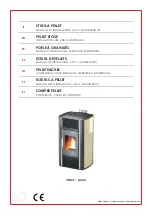
7
FW7I 23/07/14
Tertiary Air
This appliance is also fitted with a preheated tertiary air system which burns otherwise uncombusted gases
in the products of combustion thereby improving efficiency, increasing heat output and decreasing unwanted
atmospheric emissions. At certain stages of burning you will notice “jets” of flame emerging near the air
holes to the rear of the firebox.
Multifuel Grate
This stove is fitted with a grate with a strong set of cast iron bars with suitable air slots and will burn most
fuels. When burning coal type fuels it is important to stoke the fire well where required to de-ash regularly,
to ensure that the primary airflow is not impeded, as a build-up of ash
when burning coal
can damage the
cast iron grate
.
A build up of ash when burning wood will not usually harm the grate and indeed wood burns
better on a bed of wood ash building up. Excessive wood ash build up is not to be recommended however as
this would decrease the size of the firebox and consequently decrease the amount of fuel that can be put in
the stove.
Ashpan
It is essential that you empty the steel ash pan every day. Use the thick end of tool to hook onto and lift the
ash pan out of the stove.
DO NOT allow ash to build up underneath the bed as this may cause damage
to the grate.
Cleaning
Glass:
Despite the advanced air wash system provided, the glass will still need cleaning from time to time
depending on the fuel quality and burning rates used. Never clean glass when the stove is hot. Always use
stove glass cleaner or ceramic hob cleaner, which is available from your stove retailer. As an alternative, use
a wet cloth with some of the wood ash if burning wood but be very careful to use very clean ash so as not to
scratch the glass.
Outer body:
The outer body simply needs to be dusted from time to time. DO NOT use any kind of furniture polish or
cleaning agent other than your stove suppliers recommended paint.
Inner firebox:
Brush the inside of the firebox clean from time to time to check the integrity of the plates and liners etc. It is
not normally necessary to re-paint inside the firebox due to the high temperatures that mean that the paint
does not have much effect before being burnt off. Steel and cast iron liners are resilient firebox materials and
will give reliable service without major cleaning or work on the firebox.
Baffle:
It is essential to check the top of the baffle for build-up of soot and ash regularly when in use and after a
long period of no use. From time to time remove the baffle if necessary to ensure that the flue way entrance
is clear. Take note of the baffle orientation when removing and ensure it is refitted the same way.
































